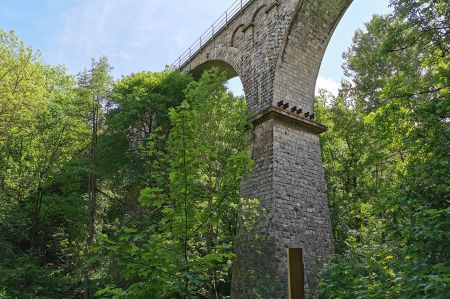Viaducts of the former Finnebahn near Bad Bibra
- Written by Portal Editor
The two viaducts between Bad Bibra and Saubach were probably the most difficult part of the construction of the Laucha – Kölleda railway line, the so-called Finnebahn.
These two mighty viaducts were built between 1912 and 1914. The executing construction companies used many foreign workers from Poland, what was now Yugoslavia and Italy. Very durable sandstone was used for the viaduct, which was quarried at Kirchscheide and Steinbach. Unfortunately, this section of the railway line was also shut down.
With the e-bike to the Schnecktal Bridge
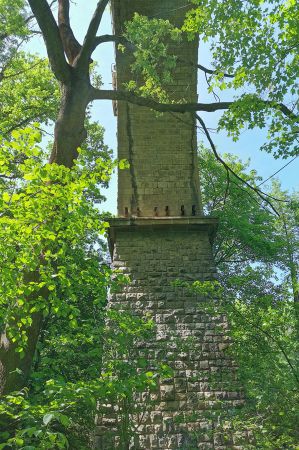 On a first bike tour in the direction of Bad Bibra and Freiburg, we had already visited the first of the two viaducts – the 12 Apostle Viaduct – which is located directly on the bike path and is also clearly visible from the main road. The 12 Apostles Bridge is 20 meters high and has 6 mighty arches. The arches are 16 meters wide. However, her name goes back to twelve willow trees planted under her, not Jesus' disciples. However, there is agreement that there is definitely an allusion to be noted here and that it should remind us of the disciples of Jesus to this day. We had already reported about this tour.
On a first bike tour in the direction of Bad Bibra and Freiburg, we had already visited the first of the two viaducts – the 12 Apostle Viaduct – which is located directly on the bike path and is also clearly visible from the main road. The 12 Apostles Bridge is 20 meters high and has 6 mighty arches. The arches are 16 meters wide. However, her name goes back to twelve willow trees planted under her, not Jesus' disciples. However, there is agreement that there is definitely an allusion to be noted here and that it should remind us of the disciples of Jesus to this day. We had already reported about this tour.
Very hidden and hardly visible from the street is an even mightier viaduct of the former Finnebahn: the Schrecktal Bridge. After all, the Schnecktal Bridge is 29 meters high and 140 meters long. 7 bridge piers had to be set to span the Schnecktal. The arches are 18 meters wide. The difference in altitude between Bad Bibra and Saubach is more than 90 meters. A really impressive building, at least when you look up from below. Incidentally, both viaducts are now listed monuments.
Coming from Saubach crossing the ICE route
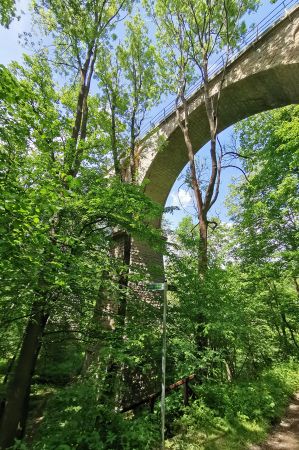 As already mentioned, the Schnecktalbrücke can hardly be seen from the main road. We came across it more or less by accident during our tour from Saubach.
As already mentioned, the Schnecktalbrücke can hardly be seen from the main road. We came across it more or less by accident during our tour from Saubach.
For those who are new to cycling in the region, it should be noted that the Schnecktalbrücke is located a few hundred meters after the ICE SAubachtalbrücke in the direction of Bad Bibra.
We had passed Saubach on the Höhenweg Bahnhofstrasse and then turned left and drove to the ICE route. Here you turn left down to the ICE Saubachtalbrücke, a paved road owned by the railway, which is often closed, or turn right to the next tunnel on the ICE route.
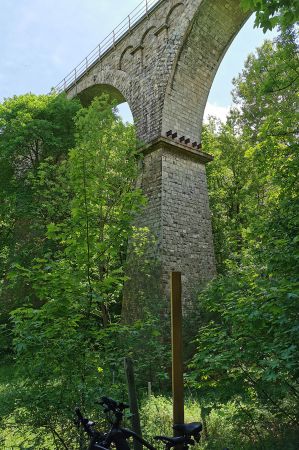 At the tunnel there is a crossing over the route and along it to the end of the paved road, then to the right it goes down at the edge of a meadow until you get to the forest path that then begins, which leads directly to the Schnecktalbrücke.
At the tunnel there is a crossing over the route and along it to the end of the paved road, then to the right it goes down at the edge of a meadow until you get to the forest path that then begins, which leads directly to the Schnecktalbrücke.
A bit adventurous, but easy to master for well-sprung bikes like the HNF XD 3.
Of course, an obligatory stop was made and the mighty structure was examined from all sides. It's exciting when you consider the effort required to build the viaduct.
In a conversation with the mayor of the Finne joint municipality, we heard that there were plans to also convert this old railway line into a cycle path. Certainly just as exciting.
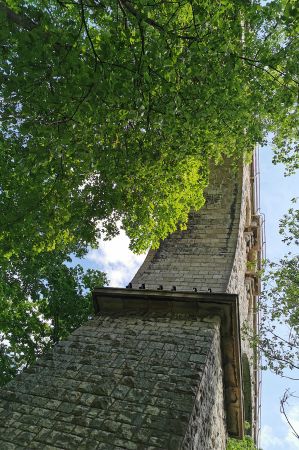 The old train station in Saubach is to become a kind of intermediate station that will also offer service and catering for cyclists.
The old train station in Saubach is to become a kind of intermediate station that will also offer service and catering for cyclists.
The further connection is then planned up to the Radacht, probably the best-known circular cycle path between Saale and Unstrut. In any case, we have enjoyed all the sections we have traveled so far and have always wished for a better connection from Billroda.
If the implementation should work, Kölleda will also be involved, which means that it is not far to Kyffhäuser.
We are excited!
Please read as well:
Gdansk - recreational & nature reserves line the bike paths
Route of industrial culture by bike and B-Turtle
-
 Old Railwaybridge Bad Bibra - Saubach
Old Railwaybridge Bad Bibra - Saubach
Old Railwaybridge Bad Bibra - Saubach
Old Railwaybridge Bad Bibra - Saubach
-
 Old Railwaybridge Bad Bibra - Saubach
Old Railwaybridge Bad Bibra - Saubach
Old Railwaybridge Bad Bibra - Saubach
Old Railwaybridge Bad Bibra - Saubach
-
 Old Railwaybridge Bad Bibra - Saubach
Old Railwaybridge Bad Bibra - Saubach
Old Railwaybridge Bad Bibra - Saubach
Old Railwaybridge Bad Bibra - Saubach
-
 Old Railwaybridge Bad Bibra - Saubach
Old Railwaybridge Bad Bibra - Saubach
Old Railwaybridge Bad Bibra - Saubach
Old Railwaybridge Bad Bibra - Saubach
-
 Old Railwaybridge Bad Bibra - Saubach
Old Railwaybridge Bad Bibra - Saubach
Old Railwaybridge Bad Bibra - Saubach
Old Railwaybridge Bad Bibra - Saubach
-
 Old Railwaybridge Bad Bibra - Saubach
Old Railwaybridge Bad Bibra - Saubach
Old Railwaybridge Bad Bibra - Saubach
Old Railwaybridge Bad Bibra - Saubach
-
 Old Railwaybridge Bad Bibra - Saubach
Old Railwaybridge Bad Bibra - Saubach
Old Railwaybridge Bad Bibra - Saubach
Old Railwaybridge Bad Bibra - Saubach
-
 Old Railwaybridge Bad Bibra - Saubach
Old Railwaybridge Bad Bibra - Saubach
Old Railwaybridge Bad Bibra - Saubach
Old Railwaybridge Bad Bibra - Saubach
-
 Old Railwaybridge Bad Bibra - Saubach
Old Railwaybridge Bad Bibra - Saubach
Old Railwaybridge Bad Bibra - Saubach
Old Railwaybridge Bad Bibra - Saubach
https://www.alaturka.info/en/germany/thuringia/5732-viaducts-of-the-former-finnebahn-near-bad-bibra?tmpl=component&print=1&layout=default#sigProIddad437e012
